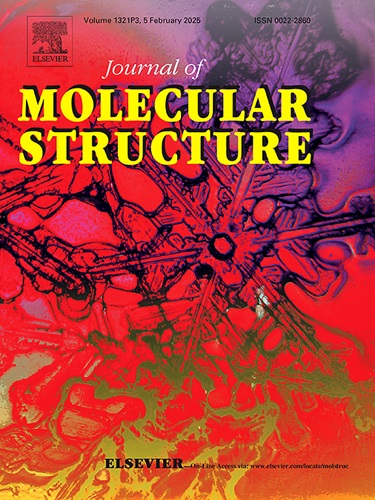新型奈韦拉平多组分晶体的制备、表征、计算与分析
IF 4
2区 化学
Q2 CHEMISTRY, PHYSICAL
引用次数: 0
摘要
奈韦拉平(NVP)水溶性差严重限制了其生物利用度。为了解决这一挑战,本工作提出了一种利用完全相互作用图(FIM)和真实溶剂类导体筛选模型(cosmos - rs)模型筛选NVP多组分晶体的有效方法。采用液体辅助研磨法和溶剂蒸发法制备了奈韦拉平-5-磺基水杨酸盐(NVP- 5sa)、奈韦拉平-2,6-二羟基苯甲酸盐(NVP- 2,6dba)、奈韦拉平-2,3-二羟基苯甲酸共晶(NVP- 2,3dba)和奈韦拉平-2,5-二羟基对苯二甲酸共晶(NVP-2,5 -二羟基对苯二甲酸共晶(NVP- 2,5dta)两种具有增强溶解度的NVP盐和两种NVP共晶。对这些多组分晶体进行了系统表征、结构分析、溶解度测量、溶出度评价和理论计算。值得注意的是,NVP- 5sa和NVP- 2,6dba在磷酸盐缓冲液(pH = 6.8)中的溶解度分别是NVP的5.32倍和3.90倍。用单晶x射线衍射对四种多组分晶体的结构进行了表征。采用Hirshfeld表面分析、分子中的原子理论、基于Hirshfeld划分的独立梯度模型和分子静电势表面等量子化学计算方法,在微观水平上研究分子相互作用。计算了NVP及其四种多组分晶体的晶格能(EL)和无水化能(EHF),并分析了这些参数与熔点和溶解行为变化的关系。因此,这些物理化学性质的变化和起源在原子尺度上得到了合理化和解释。同时,验证了新型组合共形筛选方法的有效性。本文章由计算机程序翻译,如有差异,请以英文原文为准。

New multicomponent crystals of nevirapine with improvement on solubility: preparation, characterization, calculation and analysis
The poor water solubility of nevirapine (NVP) significantly restricts its bioavailability. To address this challenge, this work proposes an efficient method for screening NVP multicomponent crystals using the full interaction map (FIM) and the Conductor-like screening model for real solvents (COSMO-RS) model. Two NVP salts and two NVP cocrystals with enhanced solubility were prepared using liquid-assisted grinding method and solvent evaporation method, namely nevirapine-5-sulfosalicylate (NVP-5SA), nevirapine-2,6-dihydroxybenzoate (NVP-2,6DBA), nevirapine-2,3-dihydroxybenzoic acid cocrystal (NVP-2,3DBA) and nevirapine-2,5-dihydroxyterephthalic acid cocrystal (NVP-2,5DTA). Systematic characterization, structural analysis, solubility measurement, dissolution evaluation and theoretical calculations were conducted on these multicomponent crystals. Notably, the solubility of NVP-5SA and NVP-2,6DBA increased to 5.32 and 3.90-fold respectively compared with NVP in phosphate buffer (pH = 6.8). The structures of four multicomponent crystals were characterized using single crystal X-ray diffraction. Quantum chemical calculations, including Hirshfeld surface analysis, atoms in molecules theory, independent gradient model based on Hirshfeld partitioning, and molecular electrostatic potentials surface, were employed to study molecular interactions at the microscopic level. The lattice energy (EL) and hydration-free energy (EHF) of NVP and its four multicomponent crystals were calculated, and the relationships between these parameters and the changes of melting point and dissolution behavior were analyzed. So, the variations and origins of these physicochemical properties were rationalized and explained on the atomic scale. Meanwhile, the efficiency of the novel combined coformers screening method was verified.
求助全文
通过发布文献求助,成功后即可免费获取论文全文。
去求助
来源期刊

Journal of Molecular Structure
化学-物理化学
CiteScore
7.10
自引率
15.80%
发文量
2384
审稿时长
45 days
期刊介绍:
The Journal of Molecular Structure is dedicated to the publication of full-length articles and review papers, providing important new structural information on all types of chemical species including:
• Stable and unstable molecules in all types of environments (vapour, molecular beam, liquid, solution, liquid crystal, solid state, matrix-isolated, surface-absorbed etc.)
• Chemical intermediates
• Molecules in excited states
• Biological molecules
• Polymers.
The methods used may include any combination of spectroscopic and non-spectroscopic techniques, for example:
• Infrared spectroscopy (mid, far, near)
• Raman spectroscopy and non-linear Raman methods (CARS, etc.)
• Electronic absorption spectroscopy
• Optical rotatory dispersion and circular dichroism
• Fluorescence and phosphorescence techniques
• Electron spectroscopies (PES, XPS), EXAFS, etc.
• Microwave spectroscopy
• Electron diffraction
• NMR and ESR spectroscopies
• Mössbauer spectroscopy
• X-ray crystallography
• Charge Density Analyses
• Computational Studies (supplementing experimental methods)
We encourage publications combining theoretical and experimental approaches. The structural insights gained by the studies should be correlated with the properties, activity and/ or reactivity of the molecule under investigation and the relevance of this molecule and its implications should be discussed.
 求助内容:
求助内容: 应助结果提醒方式:
应助结果提醒方式:


